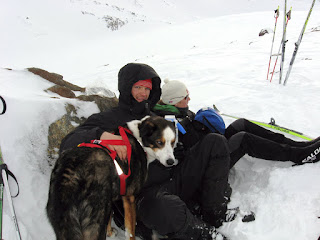The Canwell and Castner glaciers are a short 20 minute drive from the cabin trailhead, so with some of our spring break adventure time, we decided to go poke around and look for some caves. Excellent adventure is what we found.
Glaciers spend the summer melting. Small trickles of water seep under the snowpack and gather into rivulets, runnels, streams and puddles. These collections of water drip and flow their ways down moulins (french for "a hole in ze ice zat goz douwn into a glazier") and gather into a river that flows out of the end or "terminus" of the glacier. This river makes a great big 3-D tunnel in the ice, melting as it goes. In the winter, when there is no water in the tunnel, they are very cool to explore. By spring, as the ice has been moving downhill slowly all winter, the caves are as small as they will get all year. Sometimes we find pinched-off tubes or very low ceilings, but sometimes, the tunnels travel for miles deep into the belly of the beast.
Ice caving is pretty risky. It might even be as dangerous as driving in a car on a road. The formations of ice are very big, very heavy and very delicate. If you are in a cave, these formations are above you. This glacier that you are under lies directly on the Denali fault, one of the more sesmically active places in the state. There is often water in an ice cave. This water can be deep, and sometimes it looks just like the icerink floor. The idea is to sneak into the tunnel, whisper, don't bump anything, always look above you, test the ground you're walking on, carry 3 or 4 light sources, and leave soon after arriving.
The Castner was more or less a bust. The grand opening tunnel tapered pretty quickly into matching hockey rinks about 10 inches apart. Clay slid out in front of me, and had a bit of a scare. With a hollow-sounding "tong" he realized that the solid and crystal clear ice we were sliding on was really just a thin layer of ice supporting him above a deep pool of water. A speedy retreat was enacted, and we all got out safely, but wet from the overflow water.
Another tiny Castner tunnel had a thin section of small sharp rocks all frozen together. They wreaked havoc on some expensive formerly waterproof gore-tex shells. whoops.
The really cool tunnel was under the Canwell. We crawled, wiggled, slid, walked and otherwise travelled about 300 meters into the cave before encountering a tunnel too small to continue. The end was lit from the outside, and we could feel the colder air coming in. I decided to try to wiggle through the narrow spot to get into the standing room we could see behind it. Much careful, claustropohic wiggling finally got me through to the other side. To get through, I had to put both arms above my head to make my shoulders narrow enough to slide through. I then kicked with my legs and rotated my body 90 degrees to orient myself with the widest angle of the constriction. I'm not a claustrophobic person myself, but getting wedged into a cold ice tunnel isn't my idea of a good time, so I was reasonably releived when I got through. The standing room was neat, but it was the end of the tunnel. The tunnel continued, and opened into deeper passage, but only after an even narrower constriction.
Very exciting and very fun!
 Steffi chilling out under the cool frost formations at the mouth of the Castner.
Steffi chilling out under the cool frost formations at the mouth of the Castner.
A headlamp emerges from the depths.

A tight fit.

It's wet in there!









